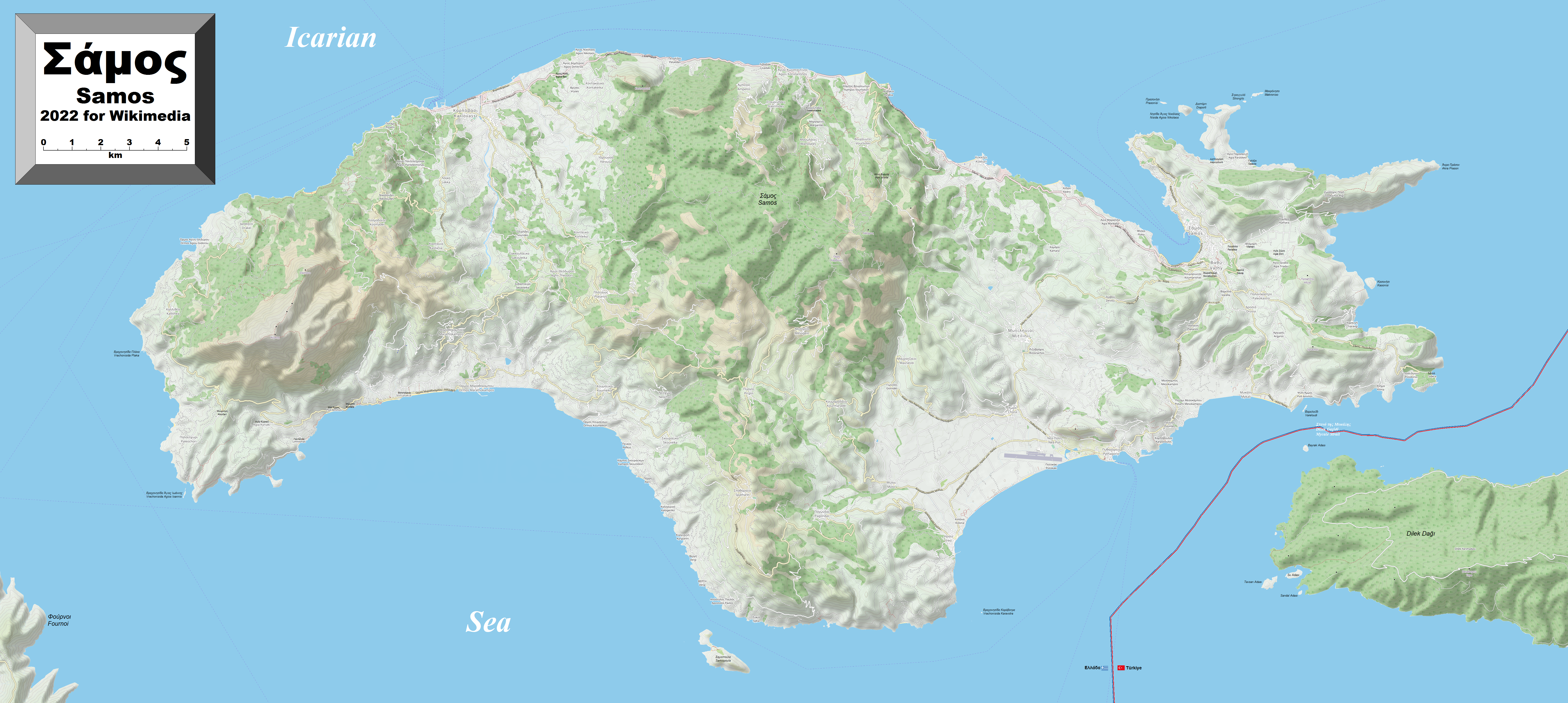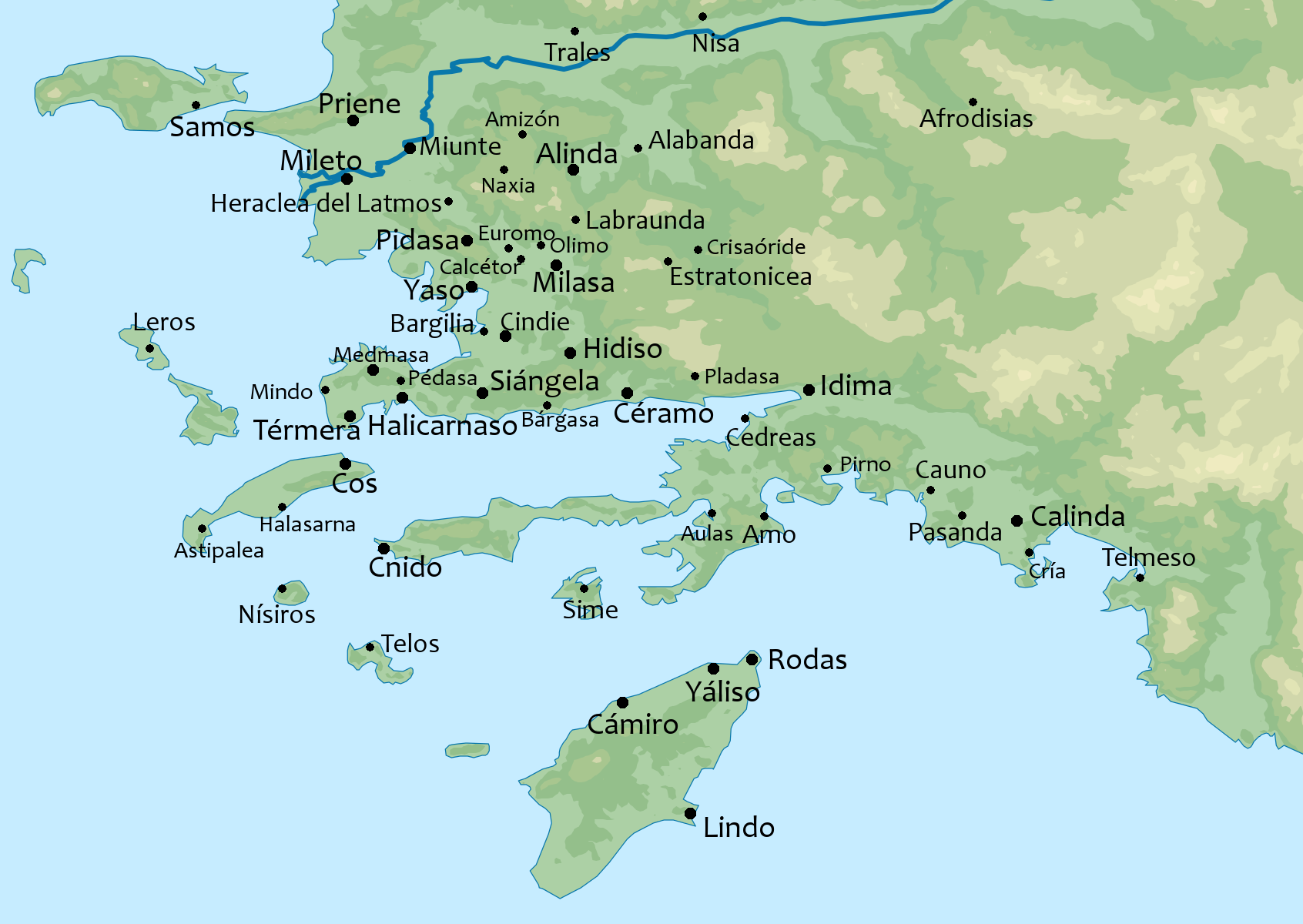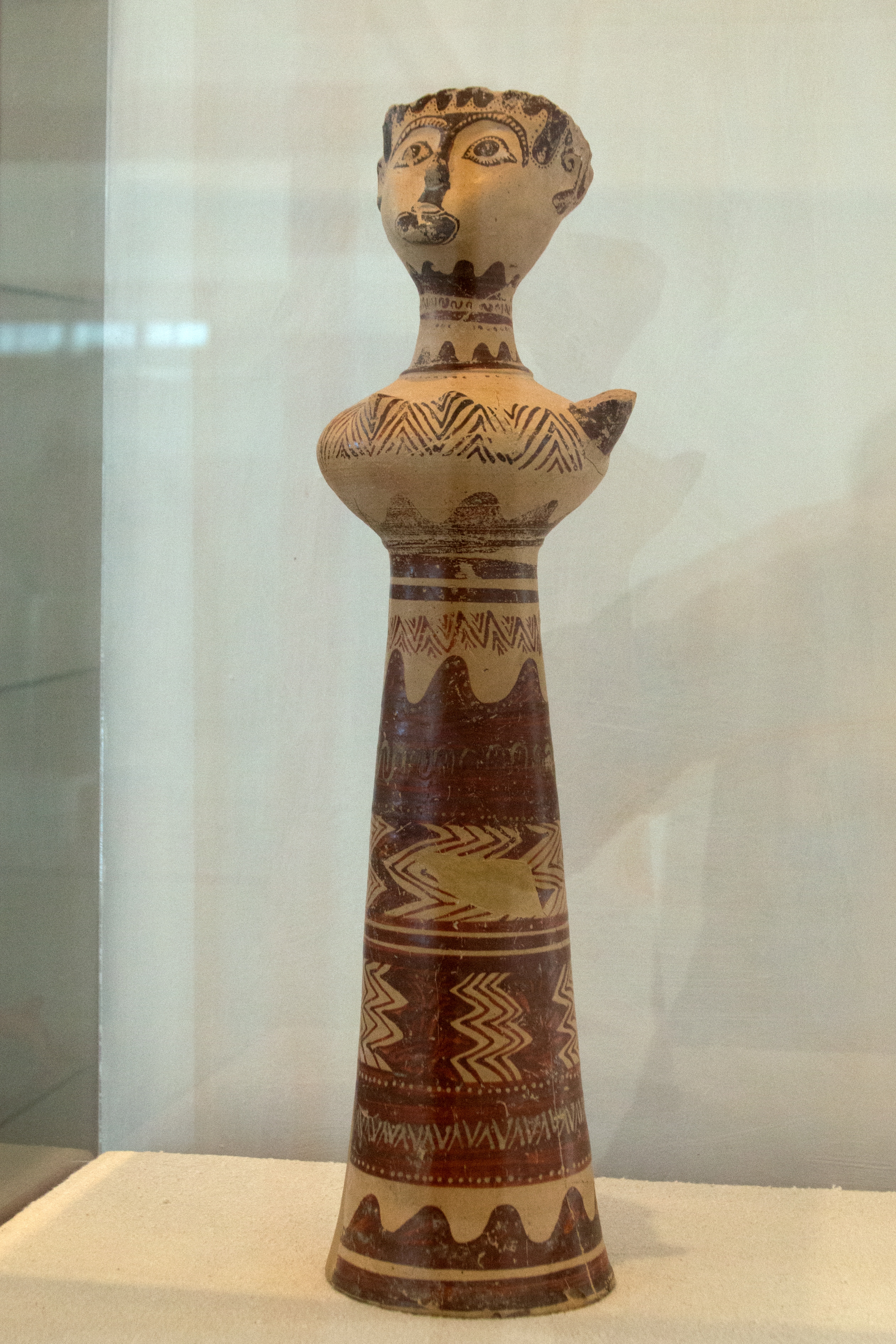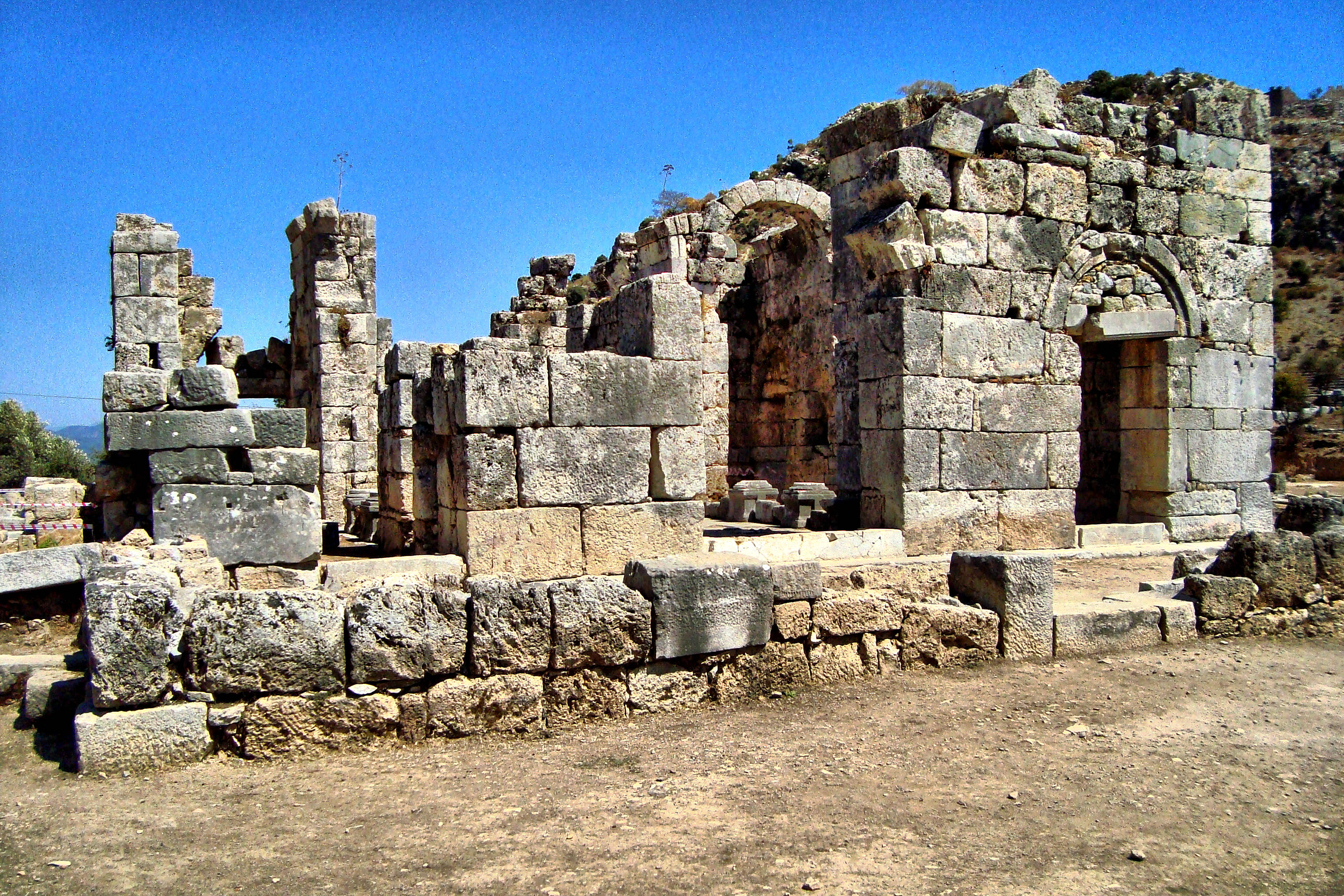|
Battle Of Syme
The Battle of Syme was a naval battle in 411 BC between Sparta and Athens, during the Peloponnesian War. It took place near the island of Syme in the south-eastern Aegean Sea.J. B. Bury, Russell Meiggs, Istoria Greciei până la moartea lui Alexandru cel Mare, p. 308 In 411 the Spartans made an alliance with Persia. The alliance was made by Therimenes, who handed the Spartan fleet over to Astyochus once the negotiations were complete; Therimenes later drowned at sea. Astyochus was instructed to sail to Cnidus to meet up with twenty-seven ships from Caunus, equipped for them by the Persians. Meanwhile, the Athenian fleet was stationed at Samos under the command of Charminus. Charminus knew the Spartans were coming, having been informed by the Melians, and prepared to meet Astyochus at Syme. The fleets met during a storm, with poor visibility, and after many of the Spartan ships had become separated from the main fleet. With about twenty ships Charminus battled with the Spartan ... [...More Info...] [...Related Items...] OR: [Wikipedia] [Google] [Baidu] |
Peloponnesian War
The Peloponnesian War (431–404 BC) was an ancient Greek war fought between Athens and Sparta and their respective allies for the hegemony of the Greek world. The war remained undecided for a long time until the decisive intervention of the Persian Empire in support of Sparta. Led by Lysander, the Spartan fleet built with Persian subsidies finally defeated Athens and started a period of Spartan hegemony over Greece. Historians have traditionally divided the war into three phases. The first phase (431–421 BC) was named the Ten Years War, or the Archidamian War, after the Spartan king Archidamus II, who launched several invasions of Attica with the full hoplite army of the Peloponnesian League, the alliance network dominated by Sparta. However, the Long Walls of Athens rendered this strategy ineffective, while the superior navy of the Delian League (Athens' alliance) raided the Peloponnesian coast to trigger rebellions within Sparta. The precarious Peace of Nicias was si ... [...More Info...] [...Related Items...] OR: [Wikipedia] [Google] [Baidu] |
Samos
Samos (, also ; el, Σάμος ) is a Greek island in the eastern Aegean Sea, south of Chios, north of Patmos and the Dodecanese, and off the coast of western Turkey, from which it is separated by the -wide Mycale Strait. It is also a separate regional unit of the North Aegean region. In ancient times, Samos was an especially rich and powerful city-state, particularly known for its vineyards and wine production. It is home to Pythagoreion and the Heraion of Samos, a UNESCO World Heritage Site that includes the Eupalinian aqueduct, a marvel of ancient engineering. Samos is the birthplace of the Greek philosopher and mathematician Pythagoras, after whom the Pythagorean theorem is named, the philosophers Melissus of Samos and Epicurus, and the astronomer Aristarchus of Samos, the first known individual to propose that the Earth revolves around the sun. Samian wine was well known in antiquity and is still produced on the island. The island was governed by the semi-autonomous ... [...More Info...] [...Related Items...] OR: [Wikipedia] [Google] [Baidu] |
Ancient Aegean Sea
The Aegean Sea ; tr, Ege Denizi (Greek language, Greek: Αιγαίο Πέλαγος: "Egéo Pélagos", Turkish language, Turkish: "Ege Denizi" or "Adalar Denizi") is an elongated embayment of the Mediterranean Sea between Europe and Asia. It is located between the Balkans and Anatolia, and covers an area of some 215,000 square kilometres. In the north, the Aegean is connected to the Marmara Sea and the Black Sea by the straits of the Dardanelles and the Bosphorus. The Aegean Islands are located within the sea and some bound it on its southern periphery, including Crete and Rhodes. The sea reaches a maximum depth of 2,639m to the west of Karpathos. The Thracian Sea and the Sea of Crete are main subdivisions of the Aegean Sea. The Aegean Islands can be divided into several island groups, including the Dodecanese, the Cyclades, the Sporades, the Saronic Islands, Saronic islands and the North Aegean islands, North Aegean Islands, as well as Crete and its surrounding islands. The ... [...More Info...] [...Related Items...] OR: [Wikipedia] [Google] [Baidu] |
410s BC Conflicts
41 may refer to: * 41 (number) * one of the years 41 BC, AD 41, 1941, 2041 Art and entertainment * ''41'' (film), a 2007 documentary about Nicholas O'Neill, the youngest victim of the Station nightclub fire * ''41'', a 2012 film by Glenn Triggs Glenn Triggs (born 1 April 1983) is an Australian screenwriter, director, producer, editor and music composer. He has directed films such as ''The Comet Kids'' (2017), ''41'' (2012), ''Apocalyptic'' (2014) and ''Dreams of Paper & Ink'' (2022). T ... * ''41'', a 2012 documentary about President George H. W. Bush. * 41 (song), "#41" (song), a song by the Dave Matthews Band * ''Survivor 41'', the 41st installment of CBS's reality program ''Survivor'' * "Forty One", a song by Karma to Burn from the album ''Appalachian Incantation'', 2010 People * George H. W. Bush, or "Bush 41" (to distinguish him from his son, George W. Bush), 41st President of the United States * Nick "41" MacLaren, member of the New Zealand hip hop duo Frontline (band), ... [...More Info...] [...Related Items...] OR: [Wikipedia] [Google] [Baidu] |
411 BC
__NOTOC__ Year 411 BC was a year of the pre-Julian Roman calendar. At the time, it was known as the Year of the Consulship of Mugillanus and Rutilus (or, less frequently, year 343 '' Ab urbe condita''). The denomination 411 BC for this year has been used since the early medieval period, when the Anno Domini calendar era became the prevalent method in Europe for naming years. Events By place Greece * June 9 – The democracy of Athens is overthrown by the oligarchic extremists, Antiphon, Theramenes, Peisander and Phrynichus in an effort by the oligarchists to exert more control over the conduct of the war with Sparta and its allies. A " Council of Four Hundred" is set up. The total defeat of the Athenian expedition to Sicily and the consequent revolts of many of the subject-allies has weakened Athenian finances severely; the acknowledged purpose of the revolutionary movement is to revise the constitution to better run Athens' finances. However, its rule is high-hand ... [...More Info...] [...Related Items...] OR: [Wikipedia] [Google] [Baidu] |
Naval Battles Of The Peloponnesian War
A navy, naval force, or maritime force is the branch of a nation's armed forces principally designated for naval and amphibious warfare; namely, lake-borne, riverine, littoral, or ocean-borne combat operations and related functions. It includes anything conducted by surface ships, amphibious ships, submarines, and seaborne aviation, as well as ancillary support, communications, training, and other fields. The strategic offensive role of a navy is projection of force into areas beyond a country's shores (for example, to protect sea-lanes, deter or confront piracy, ferry troops, or attack other navies, ports, or shore installations). The strategic defensive purpose of a navy is to frustrate seaborne projection-of-force by enemies. The strategic task of the navy also may incorporate nuclear deterrence by use of submarine-launched ballistic missiles. Naval operations can be broadly divided between riverine and littoral applications (brown-water navy), open-ocean applicati ... [...More Info...] [...Related Items...] OR: [Wikipedia] [Google] [Baidu] |
Halicarnassus
Halicarnassus (; grc, Ἁλικαρνᾱσσός ''Halikarnāssós'' or ''Alikarnāssós''; tr, Halikarnas; Carian: 𐊠𐊣𐊫𐊰 𐊴𐊠𐊥𐊵𐊫𐊰 ''alos k̂arnos'') was an ancient Greek city in Caria, in Anatolia. It was located in southwest Caria, on an advantageous site on the Gulf of Gökova, which is now in Bodrum, Turkey.} The city was famous for the Mausoleum of Halicarnassus, also known simply as the Tomb of Mausolus, whose name provided the origin of the word "mausoleum". The mausoleum, built from 353 to 350 BC, ranked as one of the seven wonders of the ancient world. Halicarnassus' history was special on two interlinked issues. Halicarnassus retained a monarchical system of government at a time when most other Greek city states had long since rid themselves of their kings. And secondly, while their Ionian neighbours rebelled against Persian rule, Halicarnassus remained loyal to the Persians and formed part of the Persian Empire until Alexander the Gre ... [...More Info...] [...Related Items...] OR: [Wikipedia] [Google] [Baidu] |
Melos
Milos or Melos (; el, label=Modern Greek, Μήλος, Mílos, ; grc, Μῆλος, Mêlos) is a volcanic Greek island in the Aegean Sea, just north of the Sea of Crete. Milos is the southwesternmost island in the Cyclades group. The ''Venus de Milo'' (now in the Louvre) and the ''Asclepius of Milos'' (now in the British Museum) were both found on the island, as were a Poseidon and an archaic Apollo now in Athens. Milos is a popular tourist destination during the summer. The municipality of Milos also includes the uninhabited offshore islands of Antimilos and Akradies. The combined land area is and the 2021 census population was 5193 inhabitants. History Obsidian (a glass-like volcanic rock) from Milos was a commodity as early as 15,000 years ago. Natural glass from Milos was transported over long distances and used for razor-sharp "stone tools" well before farming began and later: "There is no early farming village in the Near East that doesn't get obsidian". The mining o ... [...More Info...] [...Related Items...] OR: [Wikipedia] [Google] [Baidu] |
Kaunos
Kaunos (Carian: ''Kbid'';. Translator Chris Markham. Lycian: ''Khbide''; Ancient Greek: ; la, Caunus) was a city of ancient Caria and in Anatolia, a few kilometres west of the modern town of Dalyan, Muğla Province, Turkey. The Calbys river (now known as the Dalyan river) was the border between Caria and Lycia. Initially Kaunos was a separate state; then it became a part of Caria and later still of Lycia. Kaunos was an important sea port, the history of which is supposed to date back to the 10th century BC. Because of the formation of İztuzu Beach and the silting of the former Bay of Dalyan (from approx. 200 BC onwards), Kaunos is now located about 8 km from the coast.Köyceğiz-Dalyan, a journey through history within the labyrinth of nature; Altan Türe; 2011; Faya Kültür Yayınları-1; The city had two ports, the southern port at the southeast of ''Küçük Kale'' and the inner port at its northwest (the present ''Sülüklü Göl'', Lake of the Leeches). T ... [...More Info...] [...Related Items...] OR: [Wikipedia] [Google] [Baidu] |
Symi
Symi, also transliterated as Syme or Simi ( el, Σύμη), is a Greek island and municipality. It is mountainous and includes the harbor town of Symi and its adjacent upper town Ano Symi, as well as several smaller localities, beaches, and areas of significance in history and mythology. Symi is part of the Rhodes regional unit. The economy of Symi was traditionally based on the shipbuilding and sponge industries. The population reached 22,500 at its peak during that period. Symi's main industry is now tourism, and its permanent population has declined to 2,495 with a larger population during the summer. The island is known for its unique shrimps. Named "Symi's shrimps", these are small shrimps that are pan fried and eaten whole (with the shell). Geography Geographically, Symi is part of the Dodecanese island chain, located about north-northwest of Rhodes (and from Piraeus, the port of Athens), with of mountainous terrain. Its nearest land neighbors are the Datça and Bozb ... [...More Info...] [...Related Items...] OR: [Wikipedia] [Google] [Baidu] |
Cnidus
Knidos or Cnidus (; grc-gre, Κνίδος, , , Knídos) was a Greek city in ancient Caria and part of the Dorian Hexapolis, in south-western Asia Minor, modern-day Turkey. It was situated on the Datça peninsula, which forms the southern side of the Sinus Ceramicus, now known as Gulf of Gökova. By the 4th century BC, Knidos was located at the site of modern Tekir, opposite Triopion Island. But earlier, it was probably at the site of modern Datça (at the half-way point of the peninsula). It was built partly on the mainland and partly on the Island of Triopion or Cape Krio. The debate about it being an island or cape is caused by the fact that in ancient times it was connected to the mainland by a causeway and bridge. Today the connection is formed by a narrow sandy isthmus. By means of the causeway the channel between island and mainland was formed into two harbours, of which the larger, or southern, was further enclosed by two strongly built moles that are still in good part ... [...More Info...] [...Related Items...] OR: [Wikipedia] [Google] [Baidu] |
Astyochus (Spartan Navarch)
Astyochus or Astyochos ( gr, Ἀστύοχος) was a Spartan navarch who served as commander of the collective Spartan naval forces along the coast of Asia Minor from 412–411 BC. He is regarded by many contemporaries and modern scholars as a key reason for Sparta's early failures in the Ionian War. His expeditions consisting of involvements in Lesbos, Chios, Erythrae and Clazomenae all proved unsuccessful. He also refused requests for help from Chios, causing the Spartan administration to become increasingly dissatisfied with his leadership. Thucydides portrays Astyochus as timid and inept, and also depicts him often in conflict with his peers in Ionia. Toward the end of his role of commander, he exhibited great reluctance to attack the Athenians and also failed to properly pay his troops, leading to riots and violence, and eventually, his removal as commander in 412 BC, to be replaced by the Spartan Mindarus. Involvement in the Peloponnesian War In 412 BC, Astyochus replaced ... [...More Info...] [...Related Items...] OR: [Wikipedia] [Google] [Baidu] |
_-_Thucydides.jpg)






